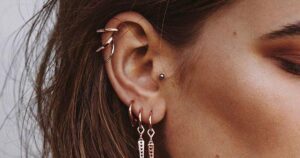Industrial piercing, also known as scaffold or bar piercing. It involves connecting two holes on the upper ear with a straight barbell. The good thing about industrial piercings lies in their unique and sharp shape. This allows for creative jewelry choices.
Many appreciate the bold and stylish statement it adds to one’s look. The downside is the potential for longer healing times. Due to the complex nature of the piercing, it increased the sensitivity. If not cared for properly, industrial piercings can become infected.
The ugly side often revolves around the pain experienced during the piercing process. This can be severe for some individuals. Choose a professional piercer by following the aftercare instructions carefully. Patience with the healing process is important to ensure a successful and visually appealing result.
Placement and Anatomy

Industrial piercing is a popular form of body modification. It involves placing a single straight barbell through two separate holes in the cartilage of the ear. The piercing usually goes through the upper ear. This unique and sharp look is achieved through precision placement, which requires skill and expertise. In fact, a team of experts, including a Professional Ear Stylist Judges BTS Members Ear Piercings, may be involved to ensure proper alignment and reduce the risk of complications.
It is very important to choose a skilled and experienced piercer who follows strict hygiene practices. The anatomy of the ear must be considered. Since individual variations can affect the piercing process. Good aspects include unique aesthetic appeal and versatility for jewelry options.
Types Of Earrings
Here are tables providing information about different types of jewelry:
| Type of Earring | Description |
| Stud Earrings | Small, typically with a single gem or metal design |
| Hoop Earrings | Circular or semicircular in shape, varying sizes |
| Dangle Earrings | Hang below the earlobe, may sway or swing |
| Huggie Earrings | Small hoop earrings that hug the earlobe |
| Ear Cuffs | Clips or wraps around the outer ear |
Procedure and Healing Process
Getting an industrial piercing involves a meticulous procedure. A skilled piercer usually uses a hollow needle to make two holes in the cartilage of the upper ear. This connects them directly to the barbell. The good news is that it can be visually striking and offer a unique aesthetic.
The bad and potentially ugly aspects arise during the healing process. Healing times can vary but it often takes several months.Proper aftercare is crucial including cleaning with saline solution and avoiding irritation.
The bad part may involve temporary discomfort, swelling and sensitivity. The ugly side can include complications such as infection or keloid formation. This emphasizes the importance of professional piercing. Attention to this to ensure a successful healing process.
Aftercare and Maintenance
Aftercare and maintenance are important aspects of ensuring the health of industrial piercing. A good one involves diligent cleaning with a saline solution. Use mild fragrance-free soaps to prevent infection.
It is important to avoid piercing with dirty hands and avoid twisting or twisting the jewelry unnecessarily. Evil includes neglect of proper care. This can lead to complications such as infection, swelling, or prolonged healing times.
Using harsh chemicals or over-cleaning can irritate the piercing. Misdiagnosis includes ignoring signs of infection such as increased redness or persistent pain. Regular checkups with a professional piercer can help resolve any issues early. This ensures a smooth healing process for industrial piercings.
Frequently Asked Questions
What is an industrial piercing?
An industrial piercing is a type of body piercing where a single straight barbell is placed horizontally through two or more holes in the upper ear cartilage. It typically connects the helix and forward helix.
Is the pain level high during an industrial piercing?
Pain tolerance varies, but many people describe the pain as moderate to high due to the thicker cartilage involved. However, pain is subjective, and experiences differ among individuals.
What are the benefits of an industrial piercing?
The aesthetic appeal and versatility are common benefits. Industrial piercings offer a unique and edgy look, and various jewelry options allow for personalization.
What are potential complications or risks associated with industrial piercings?
Infections, migration, and keloid formation are possible risks. Improper aftercare, poor hygiene, or using low-quality jewelry can contribute to complications.
How long does it take for an industrial piercing to heal?
Healing times vary, but it often takes 6 to 12 months or more. Proper aftercare, avoiding trauma, and using high-quality jewelry can aid in a smoother healing process.
Conclusion
Industrial piercings offer a unique and stylish way for individuals to express themselves through body modification. The good aspects include the striking appearance and versatility of jewelry options. Potential drawbacks such as prolonged healing periods and increased risk of complications constitute the bad.
The ugly side may involve improper aftercare leading to infections or keloid formation. While industrial piercings can be a captivating form of self-expression.It is important to weigh the aesthetic benefits against the potential challenges. It prioritizes diligent maintenance for a successful and safe experience.













